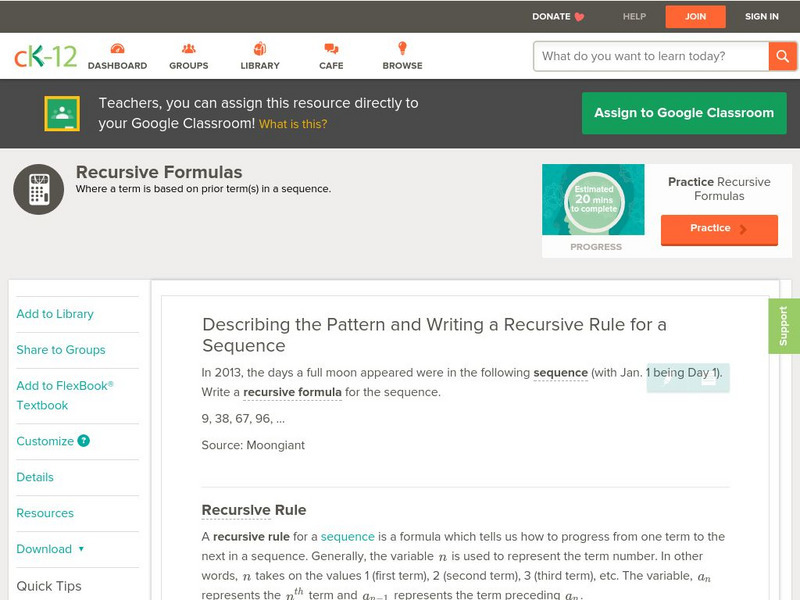Hi, what do you want to do?
Scholastic
Study Jams! Number Patterns
Finding patterns is an essential skill for mathematicians of all ages. Follow along with Zoe as she walks step-by-step through the process of identifying and completing number patterns. Work through the Try It! problems as a whole class...
Shodor Education Foundation
Sequencer
Take the first step into graphing sequences. Learners set the starting number, multiplier, add-on, and the number of steps for a sequence. Using the inputs, the interactive calculates and plots the sequence on the coordinate plane. Users...
EngageNY
Modeling from a Sequence
Building upon previous knowledge of sequences, collaborative pairs analyze sequences to determine the type and to make predictions of future terms. The exercises build through arithmetic and geometric sequences before introducing...
EngageNY
Integer Sequences—Should You Believe in Patterns?
Help your class discover possible patterns in a sequence of numbers and then write an equation with a lesson plan that covers sequence notation and function notation. Graphs are used to represent the number patterns.
EngageNY
Arithmetic and Geometric Sequences
Arithmetic and geometric sequences are linear and geometric patterns. Help pupils understand the relationship and see the connection with an activity that asks them to write the rules and classify the patterns correctly. A sorting...
Mathematics Vision Project
Module 3: Arithmetic and Geometric Sequences
Natural human interest in patterns and algebraic study of function notation are linked in this introductory unit on the properties of sequences. Once presented with a pattern or situation, the class works through how to justify...
Mathematics Vision Project
Module 1: Sequences
Sequences are all about recognizing patterns. A module of 11 lessons builds pupils' understanding of sequences through pattern analysis. The practice connects the analysis to linear and exponential equations. This is the first module in...
EngageNY
Recursive Formulas for Sequences
Provide Algebra I learners with a logical approach to making connections between the types of sequences and formulas with a lesson that uses what class members know about explicit formulas to develop an understanding of...
CK-12 Foundation
Sequence: The Sequence Calculator
Work through a sequence in discovering number patterns. Using the interactive, pupils explore arithmetic and geometric sequences by setting the initial value and the common difference or ratio. Learners distinguish between the two types...
Concord Consortium
Boards IV
Build a connection between algebraic sequences and spreadsheets. Learners examine a specific folding pattern and convert the pattern into a spreadsheet. The goal of the spreadsheet is to produce a sequence of a specific pattern modeled...
Concord Consortium
Boards III
Learn to visualize mathematical patterns as a folded pattern. Beginning with a visual display, the task encourages pupils to view sequences as a folded table. The pattern of the table then becomes a formula in a spreadsheet that...
Inside Mathematics
Conference Tables
Pupils analyze a pattern of conference tables to determine the number of tables needed and the number of people that can be seated for a given size. Individuals develop general formulas for the two growing number patterns and...
Noyce Foundation
Tri-Triangles
Develop an understanding of algebraic sequences through an exploration of patterns. Five leveled problems target grade levels from elementary through high school. Each problem asks young mathematicians to recognize a geometric pattern....
Noyce Foundation
Toy Trains
Scholars identify and continue the numerical pattern for the number of wheels on a train. Using the established pattern and its inverse, they determine whether a number of wheels is possible. Pupils finish...
Bowland
Patchwork Cushions
Find out if there are enough squares. Given diagrams for the first four figures in a sequence, pupils try to determine the next figure. Individuals find the number of square and triangle pieces of fabric that are required to make...
Scholastic
Week 19 Questions
Present your young mathematicians with a new challenge each day. Fractions on Monday, Tuesday is 2's Day, Wednesday is for squares, Thursday is 99 cents day, and by Friday it's time to deal with time. In addition, just for fun, there's a...
CK-12 Foundation
Ck 12: Elem Math: Finding and Completing Growth Pattern Sequences
[Free Registration/Login may be required to access all resource tools.] In this learning module, students must identify a simple pattern in a series of numbers and continue the pattern. Includes video demonstrating a sample problem...
CK-12 Foundation
Ck 12: Elem Math: Finding and Completing the Number Patterns
[Free Registration/Login may be required to access all resource tools.] In this learning module, students must identify the pattern in a series of numbers and fill in the missing numbers. Includes video demonstrating a sample problem...
Mathigon
Mathigon: Algebra: Special Sequences
In addition to arithmetic and geometric sequences, Fibonacci Numbers, and figurate numbers, there are countless interesting sequences that don't follow a similar, regular pattern. These include prime numbers, perfect numbers, the...
CK-12 Foundation
Ck 12: Analysis: Recursive Formulas
[Free Registration/Login may be required to access all resource tools.] This lesson provides a review of a variety of sequence types including recursive, arithmetic, and geometric. Students examine guided notes, review guided practice,...
Fun Brain
Fun Brain: Number Cracker (Number Series Game)
The Number Cracker needs you to help find a secret code by identifying the missing number in a series.
























